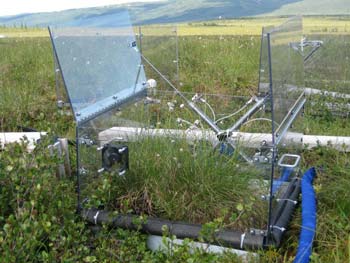Permafrost Thaw Exacerbates Climate Change

Summer warming experiment
Woods Hole Research Center (WHRC) Assistant Scientist Sue Natali and colleagues engineered first-of-a-kind warming experiments in the field to determine net gains or losses in carbon emissions. The study entitled “Permafrost degradation stimulates carbon loss from experimentally warmed tundra,” published in the journal Ecology found that growing season gains do not offset carbon emissions from permafrost thaw.
According to Dr. Natali, “Our results show that while permafrost degradation increased carbon uptake during the growing season, in line with decadal trends of ‘greening’ tundra, warming and permafrost thaw also enhanced winter respiration, which doubled annual carbon losses.”
Permafrost contains three to seven times the amount of carbon sequestered in tropical forests. The warming climate threatens to thaw permafrost, which will result in the release of carbon dioxide and methane into the atmosphere creating feedbacks to climate change – more warming and greater permafrost thaw. Prior to this study, “the understanding of permafrost feedbacks to climate change had been limited by a lack of data examining warming effects on both vegetation and permafrost carbon simultaneously,” said Dr. Natali.
This study measured CO2 emissions from permafrost thaw and its impact on the carbon balance on an ecosystem level. According to Dr. Natali, “There is 100 times more carbon stored belowground than aboveground in the arctic, so observed changes in plant productivity are only a very small component of the story. Given the amount of carbon stored belowground in the arctic, it is very unlikely that plant growth can ever fully offset C losses from permafrost thaw.”
The three year long Carbon in Permafrost Experimental Heating Research (CiPEHR) project warmed air and soil and thawed permafrost using two warming experiments. The “winter warming” treatment consisted of snow packs, which functioned like down comforters insulating the ground during the winter until the snow was removed at the start of the growing season. The “summer warming” treatment consisted of open-topped greenhouses that warmed the air during the summer. The team measured warming effects on CO2 uptake by plants and release by plants and microbes.
Scientists estimate that within the next century permafrost will have declined 30% to 70% and there is limited accounting of how much carbon is stored in these frozen soils or the rate at which it will be released. For Dr. Natali:
“The only way we can accurately project future climate is to understand the responses of both plants and microbes to a warming climate. This study was the first to simulate whole ecosystem warming in the arctic, including permafrost degradation, similar to what is projected to happen as a result of climate change. There is a strong potential for significant global carbon emissions if rates calculated here become typical for permafrost ecosystems in a warmer world.”
WHRC is an independent research institute where scientists collaborate to examine the drivers and impacts of climate change and identify opportunities for conservation around the globe.
Contact: Eunice Youmans, Director of External Affairs 508-444-1509
Email Eunice Youmans
Media Contact
More Information:
http://whrc.org/news/pressroom/PR-2014-Natali-Permafrost-Ecology.htmlAll latest news from the category: Earth Sciences
Earth Sciences (also referred to as Geosciences), which deals with basic issues surrounding our planet, plays a vital role in the area of energy and raw materials supply.
Earth Sciences comprises subjects such as geology, geography, geological informatics, paleontology, mineralogy, petrography, crystallography, geophysics, geodesy, glaciology, cartography, photogrammetry, meteorology and seismology, early-warning systems, earthquake research and polar research.
Newest articles

Sea slugs inspire highly stretchable biomedical sensor
USC Viterbi School of Engineering researcher Hangbo Zhao presents findings on highly stretchable and customizable microneedles for application in fields including neuroscience, tissue engineering, and wearable bioelectronics. The revolution in…

Twisting and binding matter waves with photons in a cavity
Precisely measuring the energy states of individual atoms has been a historical challenge for physicists due to atomic recoil. When an atom interacts with a photon, the atom “recoils” in…

Nanotubes, nanoparticles, and antibodies detect tiny amounts of fentanyl
New sensor is six orders of magnitude more sensitive than the next best thing. A research team at Pitt led by Alexander Star, a chemistry professor in the Kenneth P. Dietrich…





















